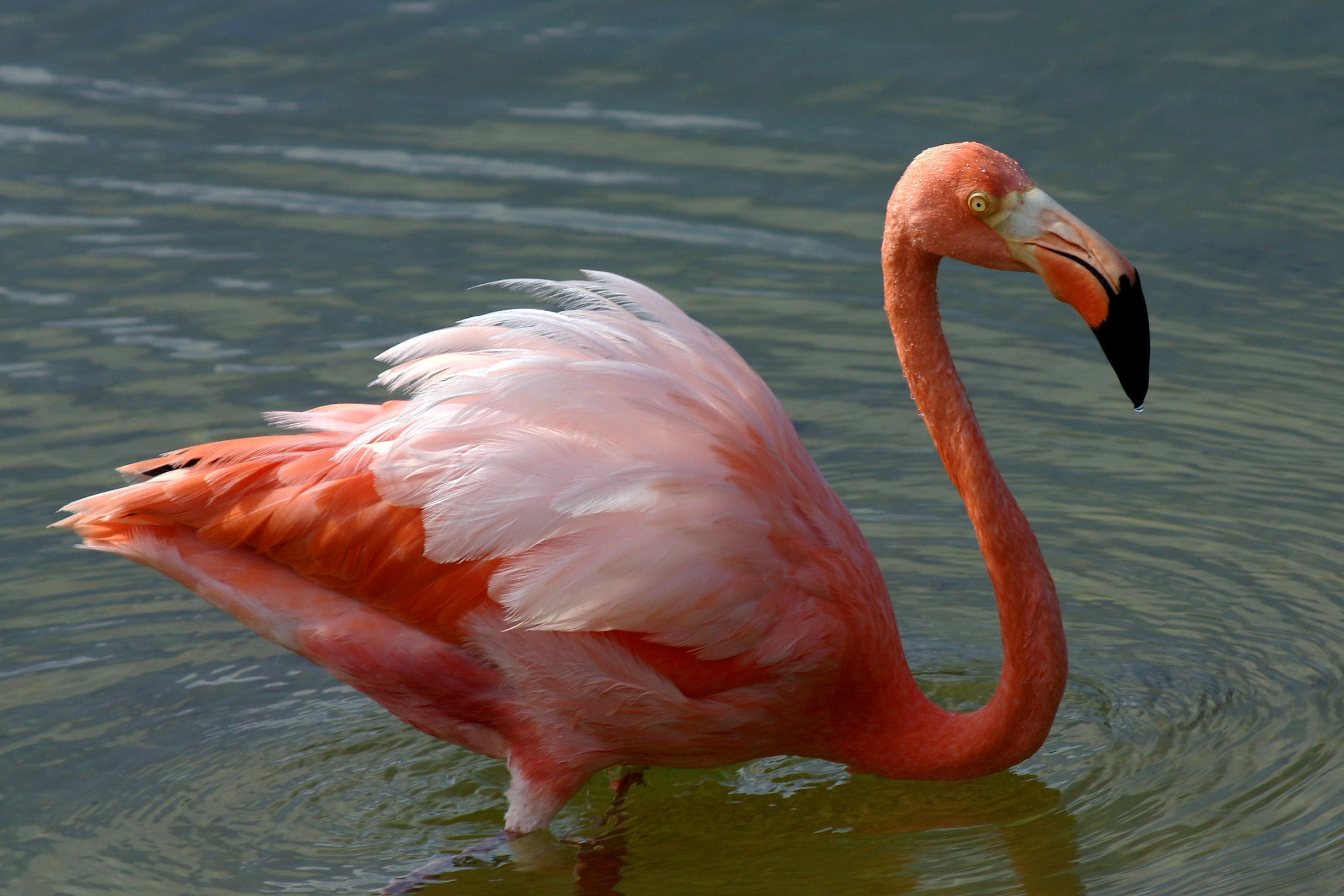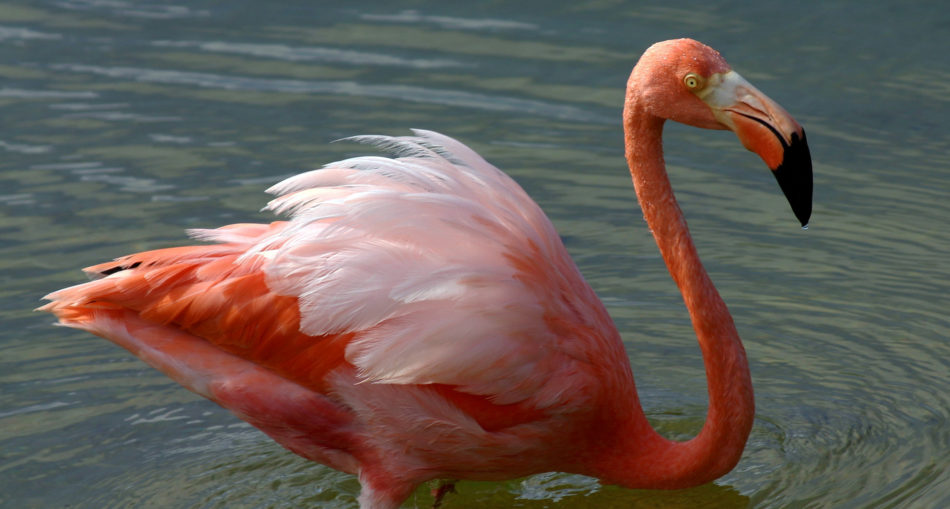I am sure that at some time, you would have witnessed a Flamingo at the seawalls or when you are going over the Demerara Harbour Bridge, but I am sure that you are not aware of which one you saw. Did you see one with a pink colouration, stilt-like legs, long necks, and astronomical bills? Then it is the American Flamingo (Phoenicopterus ruber) who are usually found in flocks in shallow, saline lagoons.
The American Flamingo is also known as the Caribbean Flamingo. There are similar species of these birds which include the Greater Flamingo, Lesser Flamingo, Chilean Flamingo, James’s Flamingo, and Andean Flamingo. The American Flamingo and the Greater Flamingo are the two most giant flamingos of the family. At first, they were considered a single species, but now, they are treated as two different species. The American flamingo usually grows between one hundred twenty (120) to one hundred forty-five (145) centimetres long and weighs between two thousand two hundred (2200) to four thousand nine hundred (4900) grams. As you continue reading, you will find more about this unmistakable creature.

The American Flamingo – Photo By Charles J Sharp – Own work, from Sharp Photography, sharpphotography, CC BY-SA 4.0, https://commons.wikimedia.org/w/index.php?curid=44938584
Description of the American Flamingo
The plumage of the adult American flamingo varies from a shiny pinkish-red to coral-red. The colours is more prominent on its head, neck, breast, and tail. As for the back and underparts, those are typically paler; pale pink to white. Once the bird is inflight its black primaries and secondaries’ flight feathers are noticeable. Additionally, the beak is usually pointed downwards with a pale yellow or whitish base, and the middle is pink to orange, and a black tip. As for the eyes, it is yellow with red inner eyering and whitish outer eyering. The legs of the American Flamingo are pale pink, darker at the joints. Its feet are webbed, suitable for being in water, with a short hind toe and three front toes.
Male Flamingoes – The male colouration is the same as the female, but the male flamingos are slightly larger than females, weighing more and having longer wingspans.
Female Flamingoes – The females are usually the smallest flamingo, standing eighty (80) centimetres.
Scientific Classification of the American Flamingo
- Kingdom: Animalia
- Phylum: Chordata
- Class: Aves
- Order: Phoenicopteriformes
- Family: Phoenicopteridae
- Genus: Phoenicopterus
- Species: P.ruber
Habitat of The American Flamingo
The American flamingo is native to Guyana but can be found in countries like the Galápagos Islands, Colombia, Venezuela, Brazil, Trinidad and Tobago, along the northern coast of the Yucatán Peninsula, some parts of the Caribbean and even in southern Florida. The American flamingo can be found in large, open, shallow ponds, mudflats and lakes with brackish or saltwater.
Interesting Tip:
- On a daily basis, flamingos usually spend 15- 30% of their time polishing their feathers, and spreading oil that was produced from a special gland over feathers with their bill.
Diet of the American Flamingo
American Flamingoes will eat almost anything that they can find, as long as they are able to filter it. Given that the American flamingo can typically be found around water, their diet consists of algae, aquatic plants, plankton, insects, fish, and small crustaceans. While they may submerge their heads in search of a meal, flamingoes typically place their crooked beaks upside down to catch small sea creatures and algae. Flamingoes are able to eat food with a high content of salt and drink saltwater because of a salt gland, found in their beaks which filters excess salt.
Behaviour & Lifestyle of the American Flamingo
These creatures are shy toward humans but are quite sociable within their species and you can find them in sizeable flocks. Despite having the ability to, these birds rarely swim. Resting flamingoes stand on one leg, holding their necks in the shape of an ‘S’. These birds have their long legs extended behind their bodies and necks protruding at the front when they are flying and so, are easily recognized.
Reproduction of the American Flamingo
A mated pair of flamingos usually lay one egg every year. Both parents then incubate for twenty-eight (28) to thirty-two (32) days. After hatching, the chick is fed for three (3) to twelve days until it joins a group of recently hatched chicks, where the flock of birds oversees their care. This young bird remains in this community for about seventy-five (75) days until it takes its first flight.
Did you know? A flamingo’s neck has nineteen (19) bones, and their feathers and beaks are made of keratin.
The American Flamingo Conservation Status
All species of the flamingos are listed in the appendix of the Convention on International Trade in Endangered Species of Wild Fauna and Flora. This is because in the 1950s these birds were rigorously threatened and were likely to become extinct if they were not protected.
The American Flamingo in Guyana
The American Flamingo is one of the largest species of flamingo and can be found in our rainforest and in areas of salty water. These remarkably social birds live in flocks which sometimes number in the thousands. The pigment in their food furnishes their feathers with their distinctive, flamboyant pink colour. The next time you are passing through our waterways, be sure to check and see if you can spy the colourful American Flamingo.
Articles References
- https://en.wikipedia.org/wiki/American_flamingo
- https://www.thespruce.com/american-flamingo-profile-387143
- http://www.oiseaux-birds.com/card-american-flamingo.html
- https://newsroom.gy/2019/11/04/person-selling-live-flamingo-in-cruel-manner-could-face-heavy-fine-jail/#:~:text=All%20species%20of%20Flamingos%20are,the%20trade%20isn’t%20regulated.








1 Comment